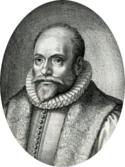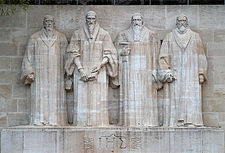Synod of Dort: Difference between revisions
wording in lead - "countries" is unclear |
|||
| Line 65: | Line 65: | ||
* [http://www.crcna.org/pages/dort_canons_main.cfm Canons of Dort] at CRC home |
* [http://www.crcna.org/pages/dort_canons_main.cfm Canons of Dort] at CRC home |
||
* [http://www.reformed.org/documents/canons_of_dordt.html Canons of Dort] at Reformed.org |
* [http://www.reformed.org/documents/canons_of_dordt.html Canons of Dort] at Reformed.org |
||
* [http://www.prdl.org/author_view.php?a_id=2316 Works] at the [[Post-Reformation Digital Library]] |
|||
* [http://www.truecovenanter.com/gospel/synod_of_dort.html The Ivdgement of the Synode Holden At Dort] |
* [http://www.truecovenanter.com/gospel/synod_of_dort.html The Ivdgement of the Synode Holden At Dort] |
||
Revision as of 23:27, 31 October 2011
This article needs additional citations for verification. (January 2010) |

- Dates in this article are according to the Julian Calendar. Sources using the Old Style calendar will need to be adjusted by adding ten days.
The Synod of Dort (also known as the Synod of Dordt or the Synod of Dordrecht) was a National Synod held in Dordrecht in 1618-1619, by the Dutch Reformed Church, to settle a divisive controversy initiated by the rise of Arminianism. The first meeting was on November 13, 1618, and the final meeting, the 154th, was on May 9, 1619. Voting representatives from eight foreign Reformed churches were also invited. Dort was a contemporary English term for the town of Dordrecht (and it remains the local colloquial pronunciation).
Background
There had been previous provincial synods of Dort, and a National Synod in 1576. For that reason the 1618 meeting is sometimes called the Second Synod of Dort.
The acts of the Synod were tied to political intrigues that arose during the Twelve Year Truce, a pause in the Dutch war with Spain. After the death of Jacob Arminius his followers presented objections to the Belgic Confession and the teaching of John Calvin, Theodore Beza, and their followers. These objections were published in a document called The Remonstrance of 1610, and the Arminians were therefore also known as Remonstrants. They taught election on the basis of foreseen faith, a universal atonement, resistible grace, and the possibility of lapse from grace. The opposing Calvinists or Gomarists, led by Franciscus Gomarus of the University of Leiden, became known as the Contra-Remonstrants.
The Arminians were perceived as ready to compromise with the Spanish, whereas the orthodox Dutch Calvinists were not, so Arminianism was considered by some to be political treason; in 1617–8 there was a pamphlet war and Francis van Aarssens expressed the view that the Arminians were working for Philip IV of Spain.[1] Planning for a National Synod was begun by Adriaan Pauw in March 1618.[2] Before that, there had been a debate as to whether the synod should be national, as the Contra-Remonstrants wished, or provincial for Holland, as the Remonstrants argued. This decision was worked out in 1617, with outside input from the English ambassador Dudley Carleton.[3]
Purpose
The purpose of the Synod was to settle the controversy over Arminianism. It was subsequently alleged that the outcome had already been decided. According to Frederick Calder, "condemnation [of the Remonstrant doctrines] was determined before the national synod met."[4] On the other hand, beyond the condemnation of the Arminians, the theological formulations of the Canons of the Synod by no means gave support to all the Gomarists wanted. The more extreme views of Dutch Calvinists were moderated in the detailed debates.[5]
Delegates
Proceedings
Simon Episcopius (1583–1643) was spokesman of the 13 representatives of the Remonstrants who were summoned before the Synod in 1618. At the opening of the synod, Episcopius asked to speak.
"Episcopius [...] insisted on being permitted to begin with a refutation of the Calvinistic doctrines, especially that of reprobation, hoping that, by placing his objections to this doctrine in front of all the rest, he might excite such prejudice against the other articles of the system, as to secure the popular voice in his favor. The Synod, however, very properly, reminded him [...] that, as the Remonstrants were accused of departing from the Reformed faith, they were bound first to justify themselves, by giving Scriptural proof in support of their opinions. The Arminians would not submit to this plan of procedure because it destroyed their whole scheme of argument [...] and were thus compelled to withdraw. Upon their departure, the Synod proceeded without them."[6]
He concluded by expressing his dissatisfaction with the organization of the assembly, and alleged that the Contra-Remonstrants had prevented an accurate representation of the Arminian supporters in the Dutch Reformed Church with votes in the synod.[7] A delegation of Episcopius, Bernard Dwinglo and Johannes Arnoldi Corvinus called on the Church of England representatives, and other coming from outside, asking for support and giving written accounts of the context. After that a month was spent on procedural matters concerning the Remonstrants. They were finally ejected from the Synod at session 57 on 14 January.[8]
The Canons of Dort
| Part of a series on |
| Arminianism |
|---|
 |
|
|
| Part of a series on |
| Reformed Christianity |
|---|
 |
|
|
The Synod concluded with a rejection of the Arminian views, and set forth the Reformed doctrine on each point, namely: total depravity, unconditional election, limited atonement (arguing the efficacy of Christ's atoning work was applicable only to the elect and not the unregenerate world), irresistible (or irrevocable) grace, and the perseverance of the saints. These are sometimes referred to as the Five points of Calvinism. The Decision of the Synod of Dort on the Five Main Points of Doctrine in Dispute in the Netherlands, popularly known as the Canons of Dort, is the explanation of the judicial decision of the Synod. In the original preface, the Decision is called a
judgment, in which both, the true view agreeing with God's word concerning the aforesaid five points of doctrine is explained and, the false view disagreeing with God's Word is rejected.
Aftermath
The thirteen Remonstrant ministers, including Episcopius, had been charged to remain in Dort until further instruction. On May 20, 1619, the Remonstrant ministers who had been present were summoned by the lay-commissioners of the synod and directed to abstain from ministerial activities such as preaching, exhorting, administering the sacraments, and visiting the sick. Furthermore, Episcopius was commanded not to write letters or books promoting the doctrines of the Remonstrants. The Remonstrants agreed to refrain from ministering in the government-ordained churches, but confessed their duty to expound their doctrines wherever people would assemble to hear them.[9]
On July 5, they were called to the States-General assembly where they were requested to sign The Act of Cessation, the legalization of the order to desist from the ministry. When they refused to sign it, they were sentenced as "disturbers of the public peace" and ordered to leave the the United Provinces.[10]
Bible translation
The synod also initiated an official Dutch Bible translation (the Statenvertaling, i.e. Translation of the States) from the original languages that would be completed in 1637. Translators were appointed, and the States-General were asked to fund the project. It had a lasting impact on the standard Dutch language, which was just then beginning to gain wider acceptance and developing a literary tradition. It would remain the standard translation in Protestant churches for more than three centuries and still is used in some sister churches of the Netherlands Reformed Congregations and similar, smaller denominations.
Political impact
The Synod condemned the religious doctrine of Arminianism as heresy. There followed the political condemnation of the statesman Johan van Oldenbarnevelt who had been the protector of the Remonstrants. For the crime of general perturbation in the state of the nation, both in Church and State (treason), he was beheaded on 13 May 1619, only four days after the final meeting of the Synod. As consequence of the Arminian defeat the jurist Hugo Grotius was given a life sentence in prison; but he escaped with the help of his wife. Both Van Oldenbarnevelt and Grotius had been in fact been imprisoned since 29 August 1618.
See also
References
- Frederick Calder (1835), Memoirs of Simon Episcopius, London: Simpkin and Marshall.
- Jonathan I. Israel (1986), The Dutch Republic and the Hispanic World 1606–1661
- Jonathan I. Israel (1998), The Dutch Republic: Its Rise, Greatness and Fall
- Anthony Milton (2005), The British Delegation and the Synod of Dort (1618-1619)
Notes
- ^ Israel (1986), pp. 62–3.
- ^ Israel (1998), p. 456.
- ^ Milton, p. 2; Google Books.
- ^ Calder, pp. 270-271.
- ^ W. B. Patterson, King James VI and I and the Reunion of Christendom (1997), Ch. 8, for a full account.
- ^ Thomas Scott, The Articles of the Synod of Dort, Sprinkle Publ., 1993 reprint, p.5.
- ^ Calder, p. 311. See Chapter X for Episcopius's entire oration and chapter XI on the proceedings of the synod.
- ^ Milton, pp. 147–8; Google Books.
- ^ Calder, pp. 388-389.
- ^ Calder, p. 389.
External links
- Canons of Dort at CRC home
- Canons of Dort at Reformed.org
- Works at the Post-Reformation Digital Library
- The Ivdgement of the Synode Holden At Dort
